Cultural Triggers and Perceived Cyber Aggression
VerifiedAdded on 2023/06/15
|13
|2833
|320
AI Summary
This research aims to assess the factors that enhance cyber aggression including the cultural problems. Cyber aggression is one of the major problems among children and teenagers in the current world. This research will be aimed to assess the factors that enhance cyber aggression including the cultural problems.
Contribute Materials
Your contribution can guide someone’s learning journey. Share your
documents today.
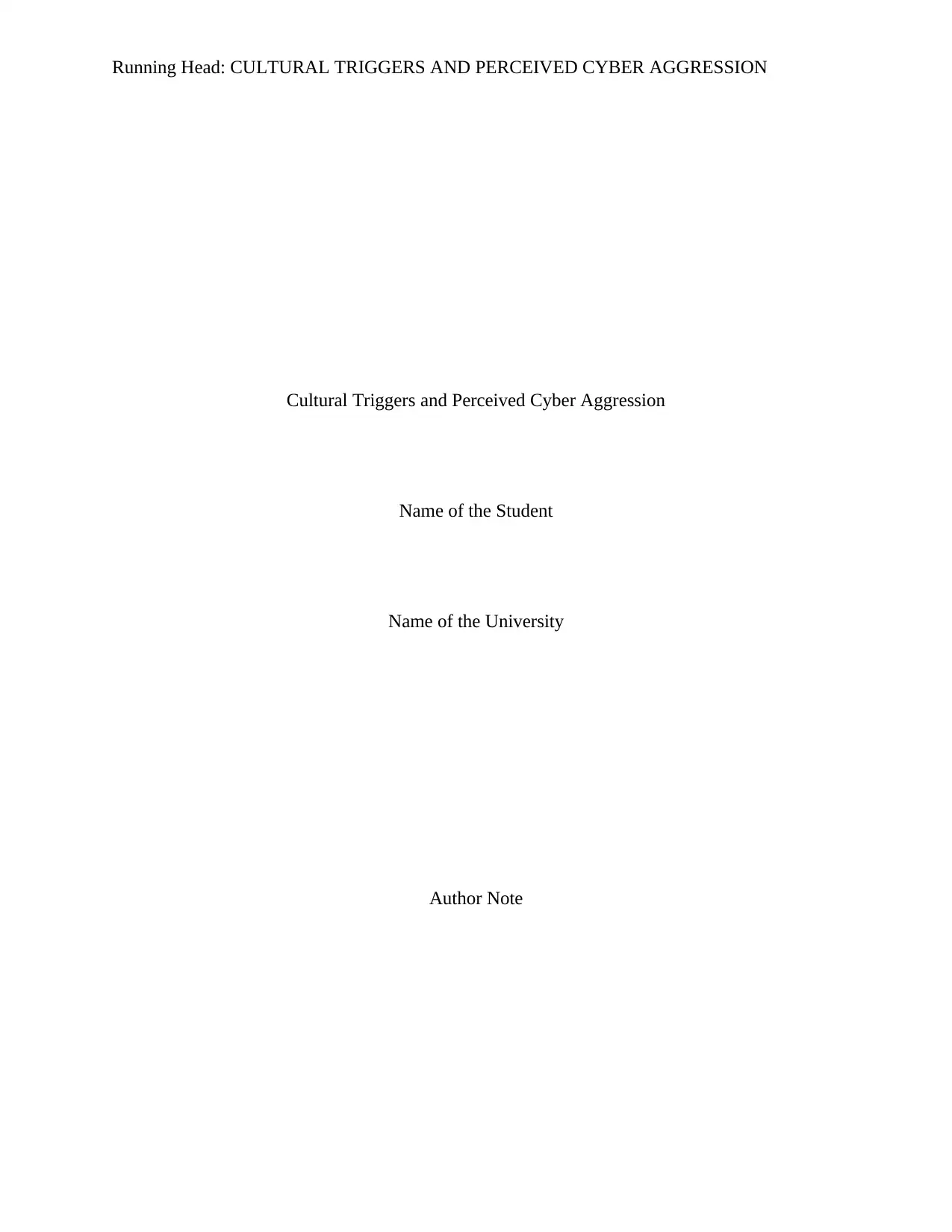
Running Head: CULTURAL TRIGGERS AND PERCEIVED CYBER AGGRESSION
Cultural Triggers and Perceived Cyber Aggression
Name of the Student
Name of the University
Author Note
Cultural Triggers and Perceived Cyber Aggression
Name of the Student
Name of the University
Author Note
Secure Best Marks with AI Grader
Need help grading? Try our AI Grader for instant feedback on your assignments.
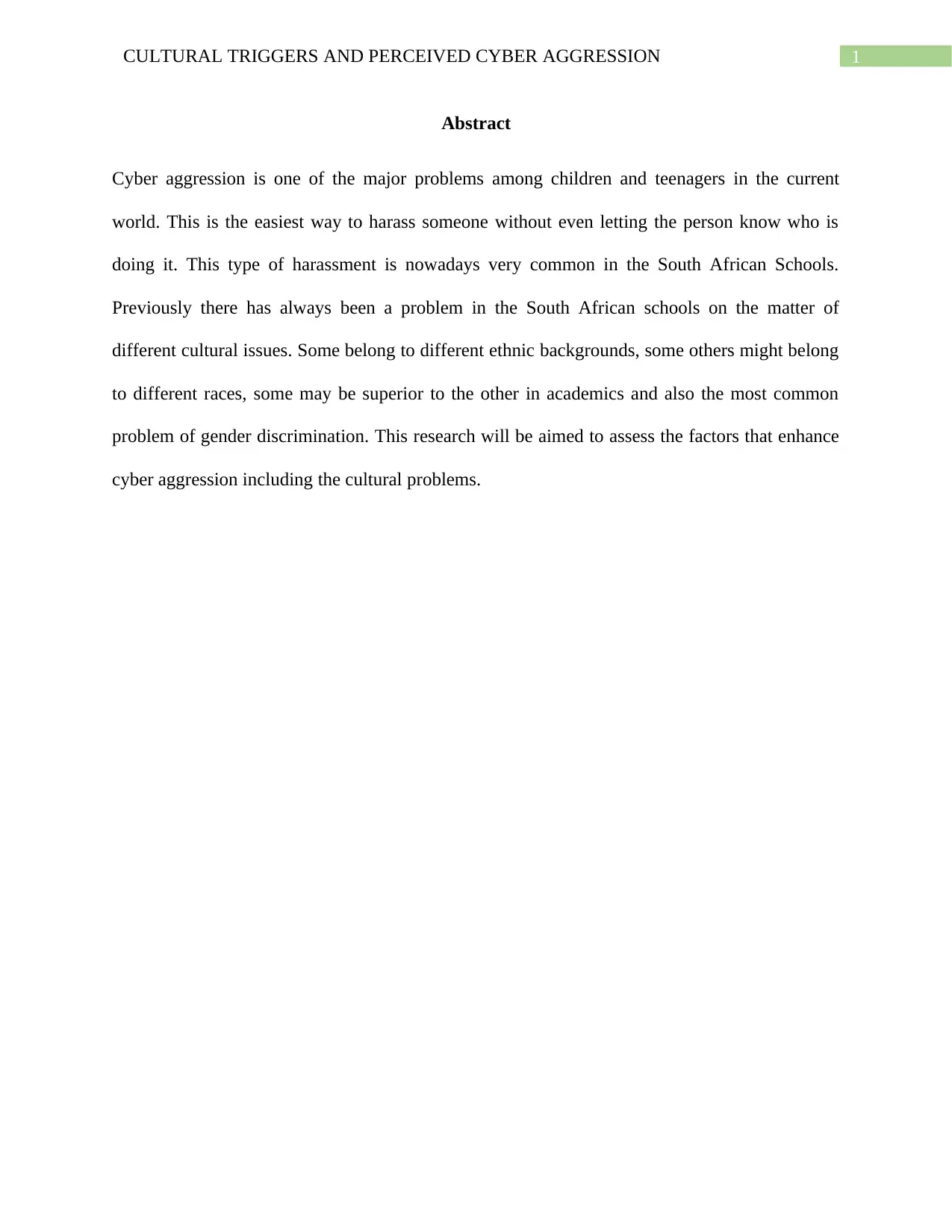
1CULTURAL TRIGGERS AND PERCEIVED CYBER AGGRESSION
Abstract
Cyber aggression is one of the major problems among children and teenagers in the current
world. This is the easiest way to harass someone without even letting the person know who is
doing it. This type of harassment is nowadays very common in the South African Schools.
Previously there has always been a problem in the South African schools on the matter of
different cultural issues. Some belong to different ethnic backgrounds, some others might belong
to different races, some may be superior to the other in academics and also the most common
problem of gender discrimination. This research will be aimed to assess the factors that enhance
cyber aggression including the cultural problems.
Abstract
Cyber aggression is one of the major problems among children and teenagers in the current
world. This is the easiest way to harass someone without even letting the person know who is
doing it. This type of harassment is nowadays very common in the South African Schools.
Previously there has always been a problem in the South African schools on the matter of
different cultural issues. Some belong to different ethnic backgrounds, some others might belong
to different races, some may be superior to the other in academics and also the most common
problem of gender discrimination. This research will be aimed to assess the factors that enhance
cyber aggression including the cultural problems.
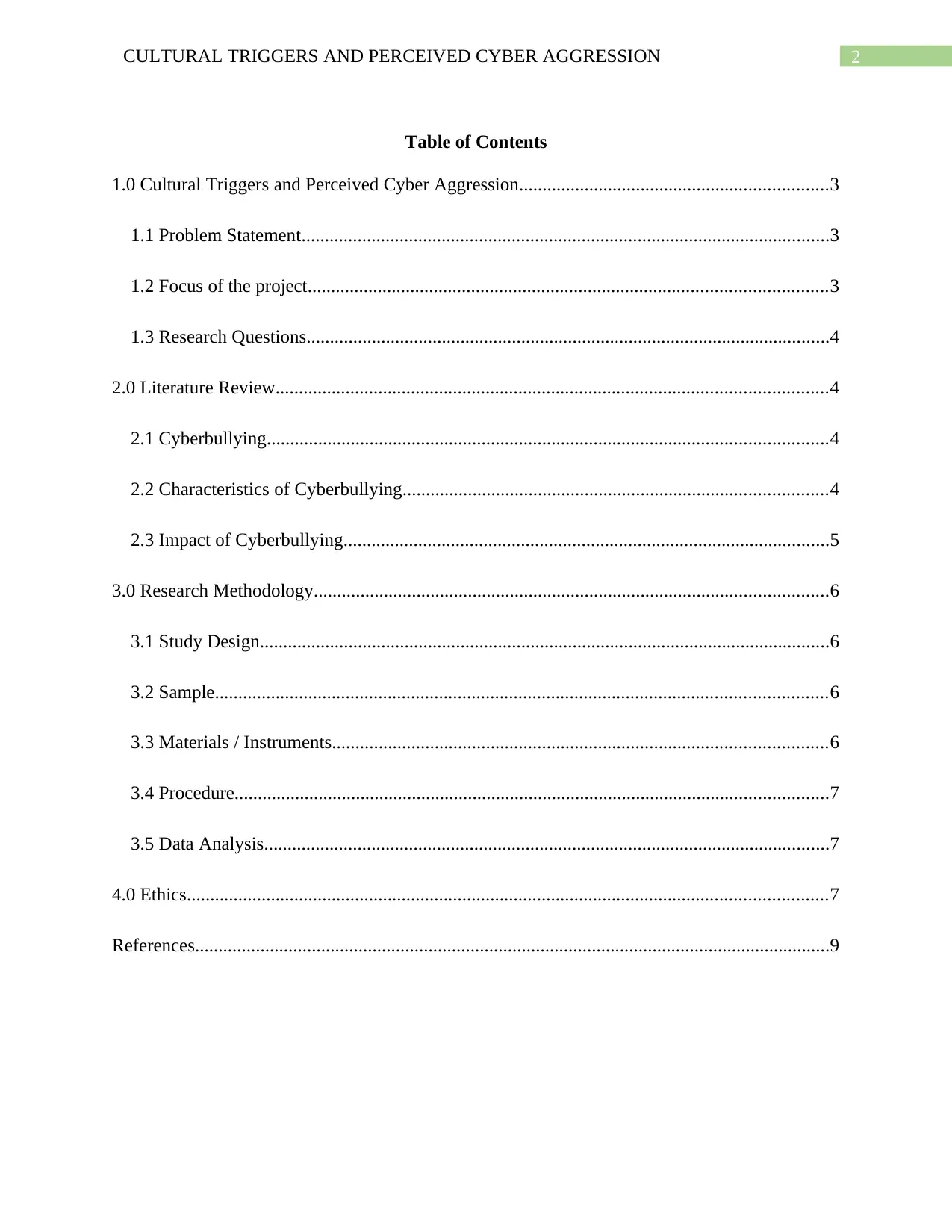
2CULTURAL TRIGGERS AND PERCEIVED CYBER AGGRESSION
Table of Contents
1.0 Cultural Triggers and Perceived Cyber Aggression..................................................................3
1.1 Problem Statement.................................................................................................................3
1.2 Focus of the project...............................................................................................................3
1.3 Research Questions................................................................................................................4
2.0 Literature Review......................................................................................................................4
2.1 Cyberbullying........................................................................................................................4
2.2 Characteristics of Cyberbullying...........................................................................................4
2.3 Impact of Cyberbullying........................................................................................................5
3.0 Research Methodology..............................................................................................................6
3.1 Study Design..........................................................................................................................6
3.2 Sample...................................................................................................................................6
3.3 Materials / Instruments..........................................................................................................6
3.4 Procedure...............................................................................................................................7
3.5 Data Analysis.........................................................................................................................7
4.0 Ethics.........................................................................................................................................7
References........................................................................................................................................9
Table of Contents
1.0 Cultural Triggers and Perceived Cyber Aggression..................................................................3
1.1 Problem Statement.................................................................................................................3
1.2 Focus of the project...............................................................................................................3
1.3 Research Questions................................................................................................................4
2.0 Literature Review......................................................................................................................4
2.1 Cyberbullying........................................................................................................................4
2.2 Characteristics of Cyberbullying...........................................................................................4
2.3 Impact of Cyberbullying........................................................................................................5
3.0 Research Methodology..............................................................................................................6
3.1 Study Design..........................................................................................................................6
3.2 Sample...................................................................................................................................6
3.3 Materials / Instruments..........................................................................................................6
3.4 Procedure...............................................................................................................................7
3.5 Data Analysis.........................................................................................................................7
4.0 Ethics.........................................................................................................................................7
References........................................................................................................................................9
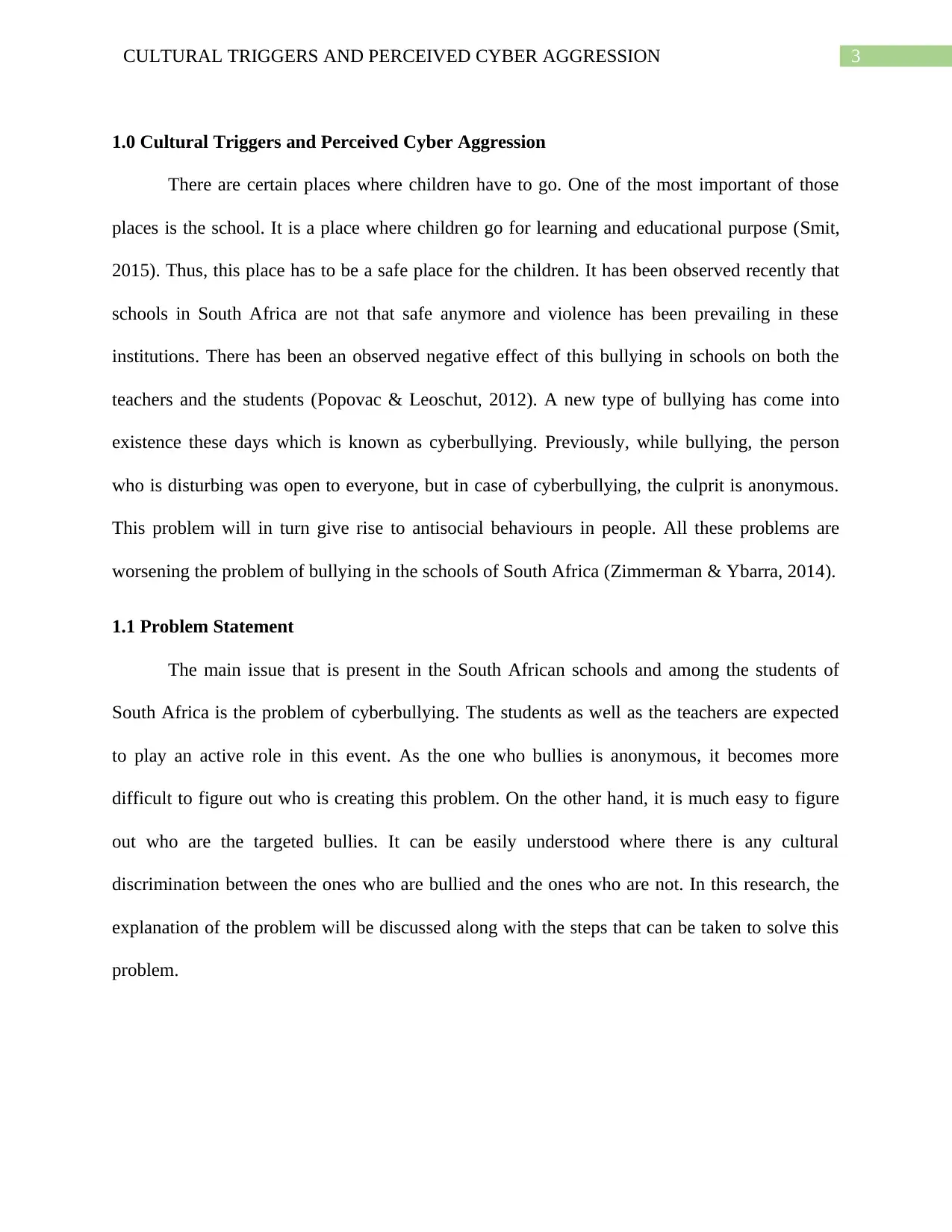
3CULTURAL TRIGGERS AND PERCEIVED CYBER AGGRESSION
1.0 Cultural Triggers and Perceived Cyber Aggression
There are certain places where children have to go. One of the most important of those
places is the school. It is a place where children go for learning and educational purpose (Smit,
2015). Thus, this place has to be a safe place for the children. It has been observed recently that
schools in South Africa are not that safe anymore and violence has been prevailing in these
institutions. There has been an observed negative effect of this bullying in schools on both the
teachers and the students (Popovac & Leoschut, 2012). A new type of bullying has come into
existence these days which is known as cyberbullying. Previously, while bullying, the person
who is disturbing was open to everyone, but in case of cyberbullying, the culprit is anonymous.
This problem will in turn give rise to antisocial behaviours in people. All these problems are
worsening the problem of bullying in the schools of South Africa (Zimmerman & Ybarra, 2014).
1.1 Problem Statement
The main issue that is present in the South African schools and among the students of
South Africa is the problem of cyberbullying. The students as well as the teachers are expected
to play an active role in this event. As the one who bullies is anonymous, it becomes more
difficult to figure out who is creating this problem. On the other hand, it is much easy to figure
out who are the targeted bullies. It can be easily understood where there is any cultural
discrimination between the ones who are bullied and the ones who are not. In this research, the
explanation of the problem will be discussed along with the steps that can be taken to solve this
problem.
1.0 Cultural Triggers and Perceived Cyber Aggression
There are certain places where children have to go. One of the most important of those
places is the school. It is a place where children go for learning and educational purpose (Smit,
2015). Thus, this place has to be a safe place for the children. It has been observed recently that
schools in South Africa are not that safe anymore and violence has been prevailing in these
institutions. There has been an observed negative effect of this bullying in schools on both the
teachers and the students (Popovac & Leoschut, 2012). A new type of bullying has come into
existence these days which is known as cyberbullying. Previously, while bullying, the person
who is disturbing was open to everyone, but in case of cyberbullying, the culprit is anonymous.
This problem will in turn give rise to antisocial behaviours in people. All these problems are
worsening the problem of bullying in the schools of South Africa (Zimmerman & Ybarra, 2014).
1.1 Problem Statement
The main issue that is present in the South African schools and among the students of
South Africa is the problem of cyberbullying. The students as well as the teachers are expected
to play an active role in this event. As the one who bullies is anonymous, it becomes more
difficult to figure out who is creating this problem. On the other hand, it is much easy to figure
out who are the targeted bullies. It can be easily understood where there is any cultural
discrimination between the ones who are bullied and the ones who are not. In this research, the
explanation of the problem will be discussed along with the steps that can be taken to solve this
problem.
Secure Best Marks with AI Grader
Need help grading? Try our AI Grader for instant feedback on your assignments.
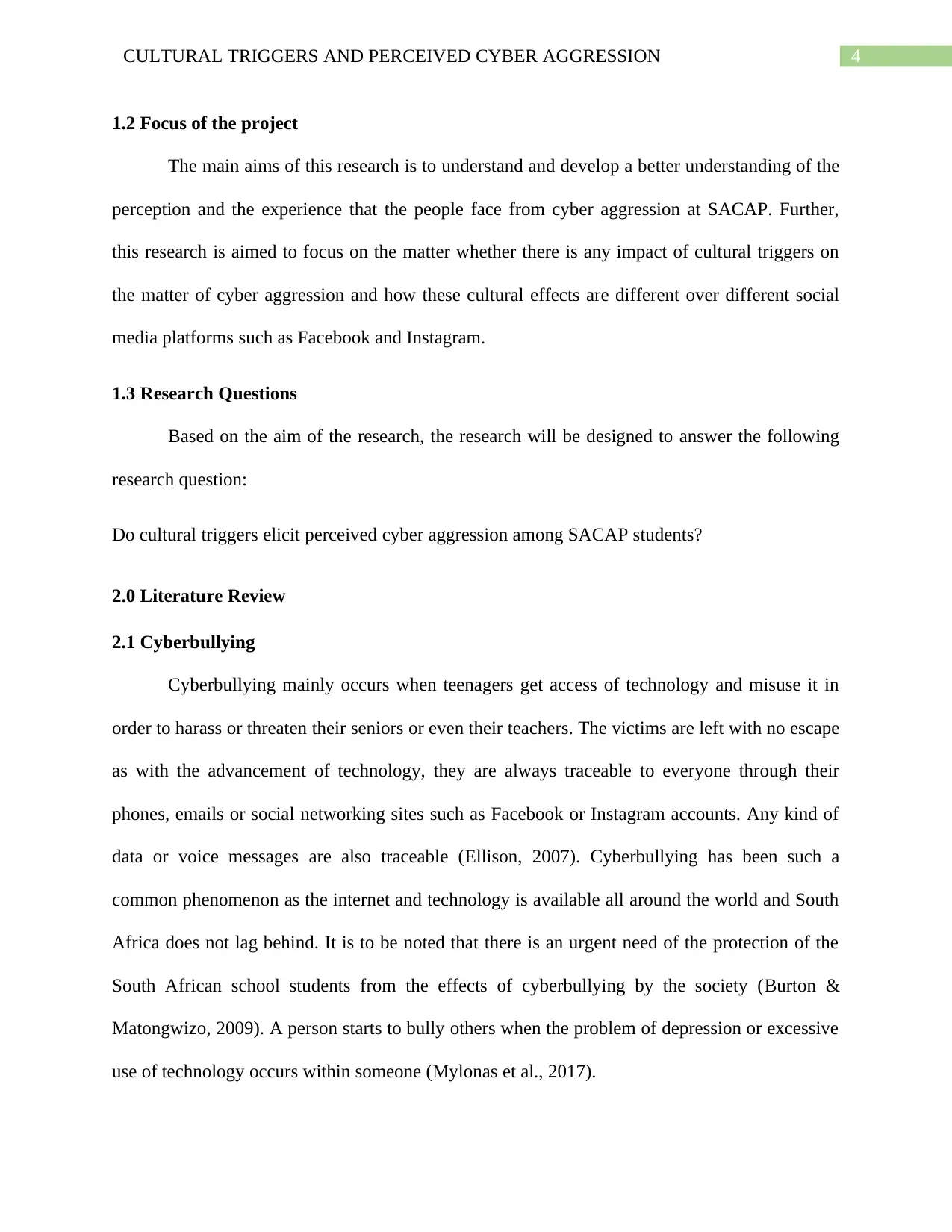
4CULTURAL TRIGGERS AND PERCEIVED CYBER AGGRESSION
1.2 Focus of the project
The main aims of this research is to understand and develop a better understanding of the
perception and the experience that the people face from cyber aggression at SACAP. Further,
this research is aimed to focus on the matter whether there is any impact of cultural triggers on
the matter of cyber aggression and how these cultural effects are different over different social
media platforms such as Facebook and Instagram.
1.3 Research Questions
Based on the aim of the research, the research will be designed to answer the following
research question:
Do cultural triggers elicit perceived cyber aggression among SACAP students?
2.0 Literature Review
2.1 Cyberbullying
Cyberbullying mainly occurs when teenagers get access of technology and misuse it in
order to harass or threaten their seniors or even their teachers. The victims are left with no escape
as with the advancement of technology, they are always traceable to everyone through their
phones, emails or social networking sites such as Facebook or Instagram accounts. Any kind of
data or voice messages are also traceable (Ellison, 2007). Cyberbullying has been such a
common phenomenon as the internet and technology is available all around the world and South
Africa does not lag behind. It is to be noted that there is an urgent need of the protection of the
South African school students from the effects of cyberbullying by the society (Burton &
Matongwizo, 2009). A person starts to bully others when the problem of depression or excessive
use of technology occurs within someone (Mylonas et al., 2017).
1.2 Focus of the project
The main aims of this research is to understand and develop a better understanding of the
perception and the experience that the people face from cyber aggression at SACAP. Further,
this research is aimed to focus on the matter whether there is any impact of cultural triggers on
the matter of cyber aggression and how these cultural effects are different over different social
media platforms such as Facebook and Instagram.
1.3 Research Questions
Based on the aim of the research, the research will be designed to answer the following
research question:
Do cultural triggers elicit perceived cyber aggression among SACAP students?
2.0 Literature Review
2.1 Cyberbullying
Cyberbullying mainly occurs when teenagers get access of technology and misuse it in
order to harass or threaten their seniors or even their teachers. The victims are left with no escape
as with the advancement of technology, they are always traceable to everyone through their
phones, emails or social networking sites such as Facebook or Instagram accounts. Any kind of
data or voice messages are also traceable (Ellison, 2007). Cyberbullying has been such a
common phenomenon as the internet and technology is available all around the world and South
Africa does not lag behind. It is to be noted that there is an urgent need of the protection of the
South African school students from the effects of cyberbullying by the society (Burton &
Matongwizo, 2009). A person starts to bully others when the problem of depression or excessive
use of technology occurs within someone (Mylonas et al., 2017).
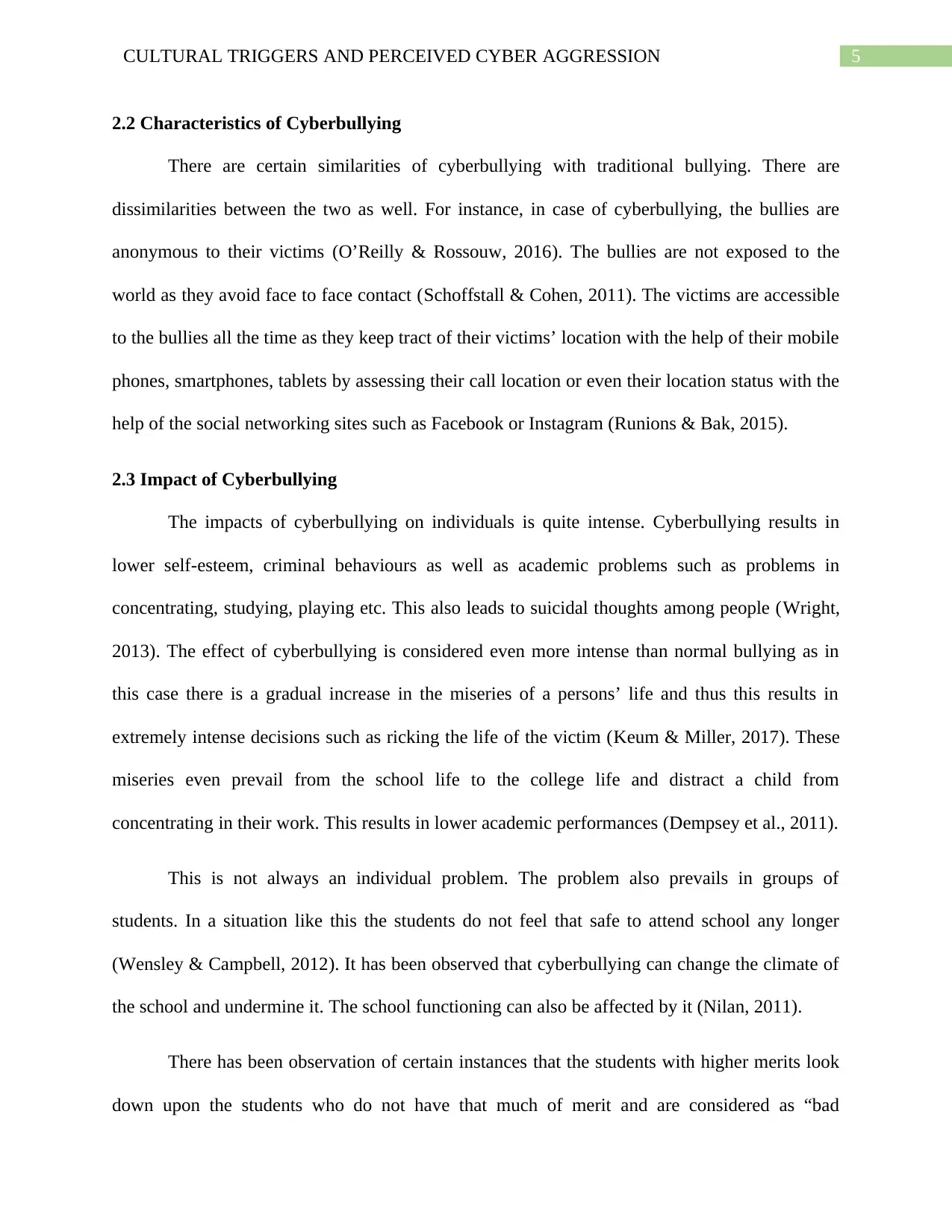
5CULTURAL TRIGGERS AND PERCEIVED CYBER AGGRESSION
2.2 Characteristics of Cyberbullying
There are certain similarities of cyberbullying with traditional bullying. There are
dissimilarities between the two as well. For instance, in case of cyberbullying, the bullies are
anonymous to their victims (O’Reilly & Rossouw, 2016). The bullies are not exposed to the
world as they avoid face to face contact (Schoffstall & Cohen, 2011). The victims are accessible
to the bullies all the time as they keep tract of their victims’ location with the help of their mobile
phones, smartphones, tablets by assessing their call location or even their location status with the
help of the social networking sites such as Facebook or Instagram (Runions & Bak, 2015).
2.3 Impact of Cyberbullying
The impacts of cyberbullying on individuals is quite intense. Cyberbullying results in
lower self-esteem, criminal behaviours as well as academic problems such as problems in
concentrating, studying, playing etc. This also leads to suicidal thoughts among people (Wright,
2013). The effect of cyberbullying is considered even more intense than normal bullying as in
this case there is a gradual increase in the miseries of a persons’ life and thus this results in
extremely intense decisions such as ricking the life of the victim (Keum & Miller, 2017). These
miseries even prevail from the school life to the college life and distract a child from
concentrating in their work. This results in lower academic performances (Dempsey et al., 2011).
This is not always an individual problem. The problem also prevails in groups of
students. In a situation like this the students do not feel that safe to attend school any longer
(Wensley & Campbell, 2012). It has been observed that cyberbullying can change the climate of
the school and undermine it. The school functioning can also be affected by it (Nilan, 2011).
There has been observation of certain instances that the students with higher merits look
down upon the students who do not have that much of merit and are considered as “bad
2.2 Characteristics of Cyberbullying
There are certain similarities of cyberbullying with traditional bullying. There are
dissimilarities between the two as well. For instance, in case of cyberbullying, the bullies are
anonymous to their victims (O’Reilly & Rossouw, 2016). The bullies are not exposed to the
world as they avoid face to face contact (Schoffstall & Cohen, 2011). The victims are accessible
to the bullies all the time as they keep tract of their victims’ location with the help of their mobile
phones, smartphones, tablets by assessing their call location or even their location status with the
help of the social networking sites such as Facebook or Instagram (Runions & Bak, 2015).
2.3 Impact of Cyberbullying
The impacts of cyberbullying on individuals is quite intense. Cyberbullying results in
lower self-esteem, criminal behaviours as well as academic problems such as problems in
concentrating, studying, playing etc. This also leads to suicidal thoughts among people (Wright,
2013). The effect of cyberbullying is considered even more intense than normal bullying as in
this case there is a gradual increase in the miseries of a persons’ life and thus this results in
extremely intense decisions such as ricking the life of the victim (Keum & Miller, 2017). These
miseries even prevail from the school life to the college life and distract a child from
concentrating in their work. This results in lower academic performances (Dempsey et al., 2011).
This is not always an individual problem. The problem also prevails in groups of
students. In a situation like this the students do not feel that safe to attend school any longer
(Wensley & Campbell, 2012). It has been observed that cyberbullying can change the climate of
the school and undermine it. The school functioning can also be affected by it (Nilan, 2011).
There has been observation of certain instances that the students with higher merits look
down upon the students who do not have that much of merit and are considered as “bad
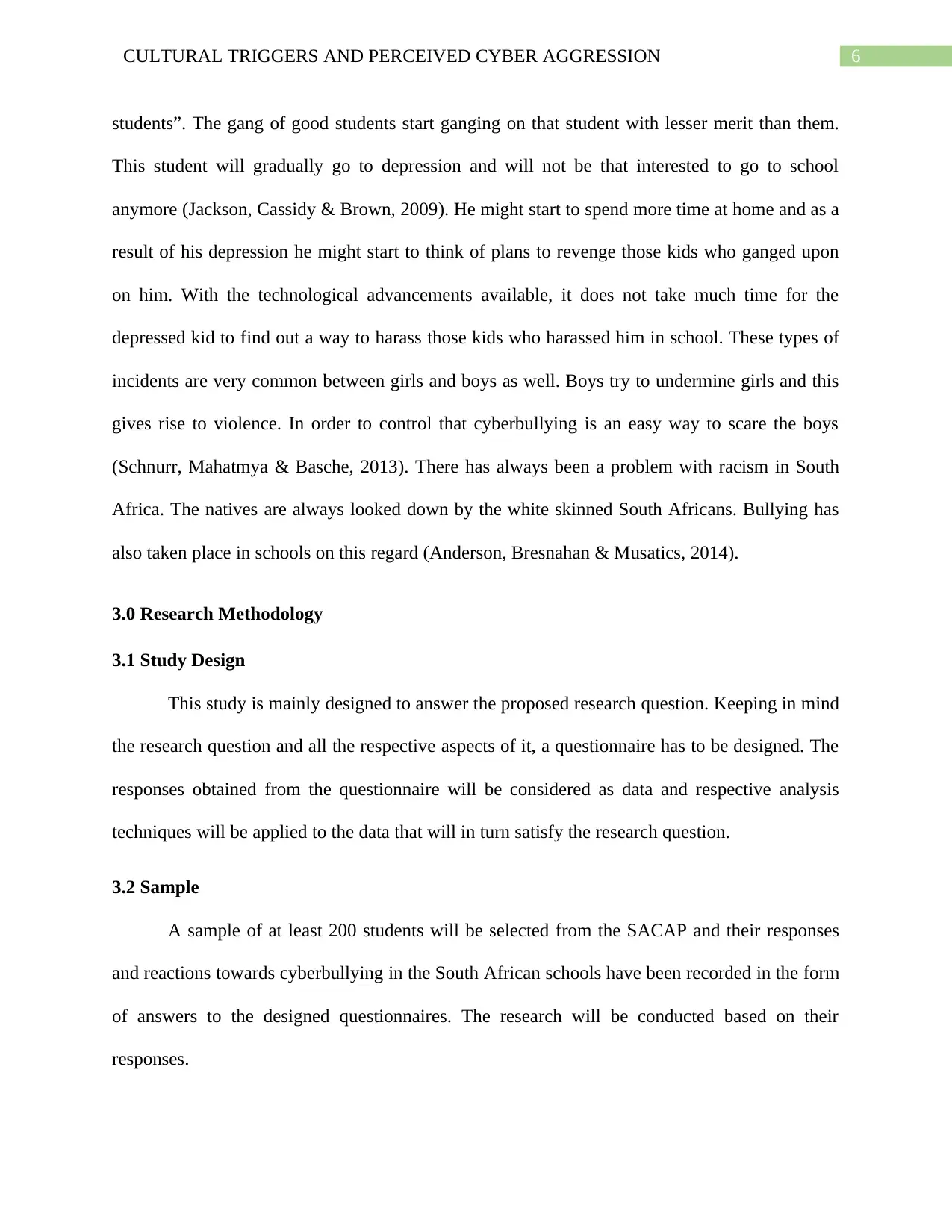
6CULTURAL TRIGGERS AND PERCEIVED CYBER AGGRESSION
students”. The gang of good students start ganging on that student with lesser merit than them.
This student will gradually go to depression and will not be that interested to go to school
anymore (Jackson, Cassidy & Brown, 2009). He might start to spend more time at home and as a
result of his depression he might start to think of plans to revenge those kids who ganged upon
on him. With the technological advancements available, it does not take much time for the
depressed kid to find out a way to harass those kids who harassed him in school. These types of
incidents are very common between girls and boys as well. Boys try to undermine girls and this
gives rise to violence. In order to control that cyberbullying is an easy way to scare the boys
(Schnurr, Mahatmya & Basche, 2013). There has always been a problem with racism in South
Africa. The natives are always looked down by the white skinned South Africans. Bullying has
also taken place in schools on this regard (Anderson, Bresnahan & Musatics, 2014).
3.0 Research Methodology
3.1 Study Design
This study is mainly designed to answer the proposed research question. Keeping in mind
the research question and all the respective aspects of it, a questionnaire has to be designed. The
responses obtained from the questionnaire will be considered as data and respective analysis
techniques will be applied to the data that will in turn satisfy the research question.
3.2 Sample
A sample of at least 200 students will be selected from the SACAP and their responses
and reactions towards cyberbullying in the South African schools have been recorded in the form
of answers to the designed questionnaires. The research will be conducted based on their
responses.
students”. The gang of good students start ganging on that student with lesser merit than them.
This student will gradually go to depression and will not be that interested to go to school
anymore (Jackson, Cassidy & Brown, 2009). He might start to spend more time at home and as a
result of his depression he might start to think of plans to revenge those kids who ganged upon
on him. With the technological advancements available, it does not take much time for the
depressed kid to find out a way to harass those kids who harassed him in school. These types of
incidents are very common between girls and boys as well. Boys try to undermine girls and this
gives rise to violence. In order to control that cyberbullying is an easy way to scare the boys
(Schnurr, Mahatmya & Basche, 2013). There has always been a problem with racism in South
Africa. The natives are always looked down by the white skinned South Africans. Bullying has
also taken place in schools on this regard (Anderson, Bresnahan & Musatics, 2014).
3.0 Research Methodology
3.1 Study Design
This study is mainly designed to answer the proposed research question. Keeping in mind
the research question and all the respective aspects of it, a questionnaire has to be designed. The
responses obtained from the questionnaire will be considered as data and respective analysis
techniques will be applied to the data that will in turn satisfy the research question.
3.2 Sample
A sample of at least 200 students will be selected from the SACAP and their responses
and reactions towards cyberbullying in the South African schools have been recorded in the form
of answers to the designed questionnaires. The research will be conducted based on their
responses.
Paraphrase This Document
Need a fresh take? Get an instant paraphrase of this document with our AI Paraphraser

7CULTURAL TRIGGERS AND PERCEIVED CYBER AGGRESSION
3.3 Materials / Instruments
Based on the research question, the following research hypothesis can be framed:
Hypothesis 1: There is a relationship between cultural triggers, and perceived cyber aggression
on Facebook among SACAP students.
Hypothesis 2: There is a relationship between cultural triggers, and perceived cyber aggression
on Instagram among SACAP students.
Hypothesis 3: There is more perceived cyber aggression among SACAP students on Instagram
than on Facebook
3.4 Procedure
The analysis conducted here will be quantitative analysis as the analysis will be
performed based on the data collected from the designed questionnaires and on the responses of
the students. The selection of the students or the participants of this research has been done
randomly as by random selection, the chances of sampling errors are minimum and the sample
selected will also be unbiased. Thus, the results obtained from the analysis can be generalised
and will give reliable estimates.
3.5 Data Analysis
The collected data is directly from the field of survey and thus, this is known as primary
data. The responses to the questions might be qualitative as well as quantitative. Thus,
appropriate statistical techniques will be implemented to analyse the data collected and also to
answer the research question.
3.3 Materials / Instruments
Based on the research question, the following research hypothesis can be framed:
Hypothesis 1: There is a relationship between cultural triggers, and perceived cyber aggression
on Facebook among SACAP students.
Hypothesis 2: There is a relationship between cultural triggers, and perceived cyber aggression
on Instagram among SACAP students.
Hypothesis 3: There is more perceived cyber aggression among SACAP students on Instagram
than on Facebook
3.4 Procedure
The analysis conducted here will be quantitative analysis as the analysis will be
performed based on the data collected from the designed questionnaires and on the responses of
the students. The selection of the students or the participants of this research has been done
randomly as by random selection, the chances of sampling errors are minimum and the sample
selected will also be unbiased. Thus, the results obtained from the analysis can be generalised
and will give reliable estimates.
3.5 Data Analysis
The collected data is directly from the field of survey and thus, this is known as primary
data. The responses to the questions might be qualitative as well as quantitative. Thus,
appropriate statistical techniques will be implemented to analyse the data collected and also to
answer the research question.

8CULTURAL TRIGGERS AND PERCEIVED CYBER AGGRESSION
4.0 Ethics
A research study always needs to follow some research ethics. The ethics that has to be
considered are discussed as below:
Informed Consent: This factor indicates that the participants of the research study must be
completely informed about the research that in being conducted. The project details such as the
group for which the research is being done or the group that is funding the total research must be
informed to the participants. The use of the findings for the purpose of the research must also be
informed to the participants.
Voluntary Participation: The participants must not be forced into the study and must be free to
withdraw their participation from any point of the study. This should not affect their participation
in any future studies negatively.
Do not Harm: There can be two types of harm that can come to a participant. It can be physical
or psychological. The participants must be assured that no harm will be produced to them as a
result of the research.
Confidentiality: Other than the coordinator of the programme, the information shared by the
participants of the research must not be available to anyone. Any information that may lead to
the identification of the participants must not be published in any reports or documents.
Anonymity: The research team must not be aware of the identity of the participants. This might
usually be a little harder to achieve as the program coordinator knows the identity of the
participants.
Assessment of Relative Components: Sometimes, a larger group of study is conducted asking
the respondents questions about various different matters. At the time of conducting the research,
4.0 Ethics
A research study always needs to follow some research ethics. The ethics that has to be
considered are discussed as below:
Informed Consent: This factor indicates that the participants of the research study must be
completely informed about the research that in being conducted. The project details such as the
group for which the research is being done or the group that is funding the total research must be
informed to the participants. The use of the findings for the purpose of the research must also be
informed to the participants.
Voluntary Participation: The participants must not be forced into the study and must be free to
withdraw their participation from any point of the study. This should not affect their participation
in any future studies negatively.
Do not Harm: There can be two types of harm that can come to a participant. It can be physical
or psychological. The participants must be assured that no harm will be produced to them as a
result of the research.
Confidentiality: Other than the coordinator of the programme, the information shared by the
participants of the research must not be available to anyone. Any information that may lead to
the identification of the participants must not be published in any reports or documents.
Anonymity: The research team must not be aware of the identity of the participants. This might
usually be a little harder to achieve as the program coordinator knows the identity of the
participants.
Assessment of Relative Components: Sometimes, a larger group of study is conducted asking
the respondents questions about various different matters. At the time of conducting the research,
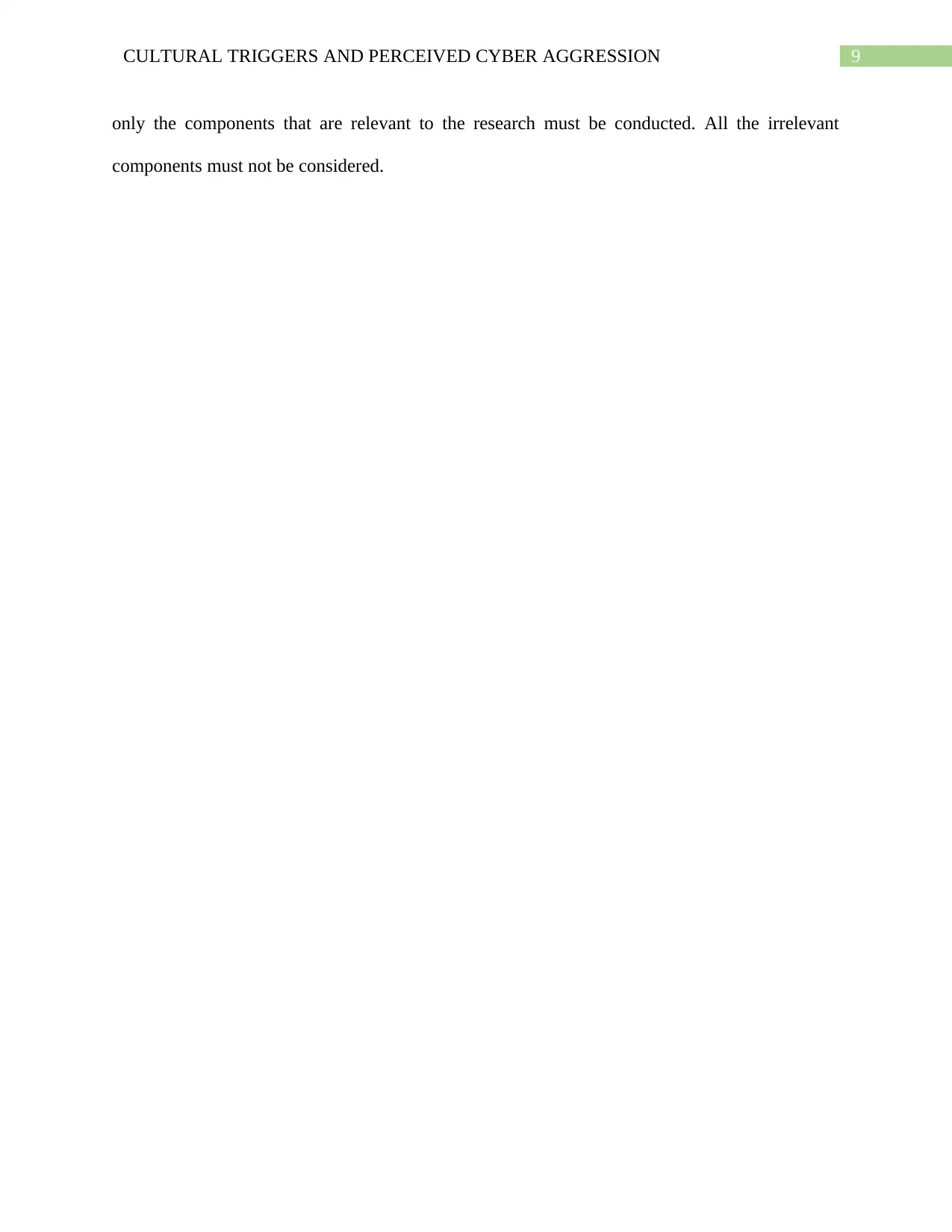
9CULTURAL TRIGGERS AND PERCEIVED CYBER AGGRESSION
only the components that are relevant to the research must be conducted. All the irrelevant
components must not be considered.
only the components that are relevant to the research must be conducted. All the irrelevant
components must not be considered.
Secure Best Marks with AI Grader
Need help grading? Try our AI Grader for instant feedback on your assignments.

10CULTURAL TRIGGERS AND PERCEIVED CYBER AGGRESSION
References
Anderson, J., Bresnahan, M., & Musatics, C. (2014). Combating weight-based cyberbullying on
facebook with the dissenter effect. CyberPsychology, Behavior & Social Networking , 17
(5), 281-286.
Burton, P., & Matongwizo, T. (2009). Inescapable violence: Cyber bullying and electronic
violence against young people in South Africa. Centre for Justice and Crime Prevention ,
8, 1-12.
Dempsey, A., Sulkowski, M., Dempsey, J., & & Storch, E. (2011). Has Cyber Technology
Produced a New Group of Peer Aggressors? Cyberpsychology, Behavior, And Social
Networking , 14 (5), 297-302.
Ellison, N. (2007). Social network sites: Definition, history, and scholarship. Journal of
Computer-Mediated Communication , 13 (1), 210-230.
Jackson, M., Cassidy, W., & Brown, K. (2009). you were born ugly and youl die ugly too":
Cyber-Bullying as Relational Aggression. e in education , 15 (2).
Keum, B. T., & Miller, M. J. (2017). Racism in digital era: Development and initial validation of
the Perceived Online Racism Scale (PORS v1.0). Journal of Counseling Psychology , 64
(3), 310-324.
Mylonas, K., Lawrence, C., Zanjenkowska, A., & Bower Russa, M. (2017). The Situational
Triggers of Aggressive Responses scale in five countries: Factor structure and country
clustering solutions. Personality and Individual Differences , 104, 172-179.
References
Anderson, J., Bresnahan, M., & Musatics, C. (2014). Combating weight-based cyberbullying on
facebook with the dissenter effect. CyberPsychology, Behavior & Social Networking , 17
(5), 281-286.
Burton, P., & Matongwizo, T. (2009). Inescapable violence: Cyber bullying and electronic
violence against young people in South Africa. Centre for Justice and Crime Prevention ,
8, 1-12.
Dempsey, A., Sulkowski, M., Dempsey, J., & & Storch, E. (2011). Has Cyber Technology
Produced a New Group of Peer Aggressors? Cyberpsychology, Behavior, And Social
Networking , 14 (5), 297-302.
Ellison, N. (2007). Social network sites: Definition, history, and scholarship. Journal of
Computer-Mediated Communication , 13 (1), 210-230.
Jackson, M., Cassidy, W., & Brown, K. (2009). you were born ugly and youl die ugly too":
Cyber-Bullying as Relational Aggression. e in education , 15 (2).
Keum, B. T., & Miller, M. J. (2017). Racism in digital era: Development and initial validation of
the Perceived Online Racism Scale (PORS v1.0). Journal of Counseling Psychology , 64
(3), 310-324.
Mylonas, K., Lawrence, C., Zanjenkowska, A., & Bower Russa, M. (2017). The Situational
Triggers of Aggressive Responses scale in five countries: Factor structure and country
clustering solutions. Personality and Individual Differences , 104, 172-179.
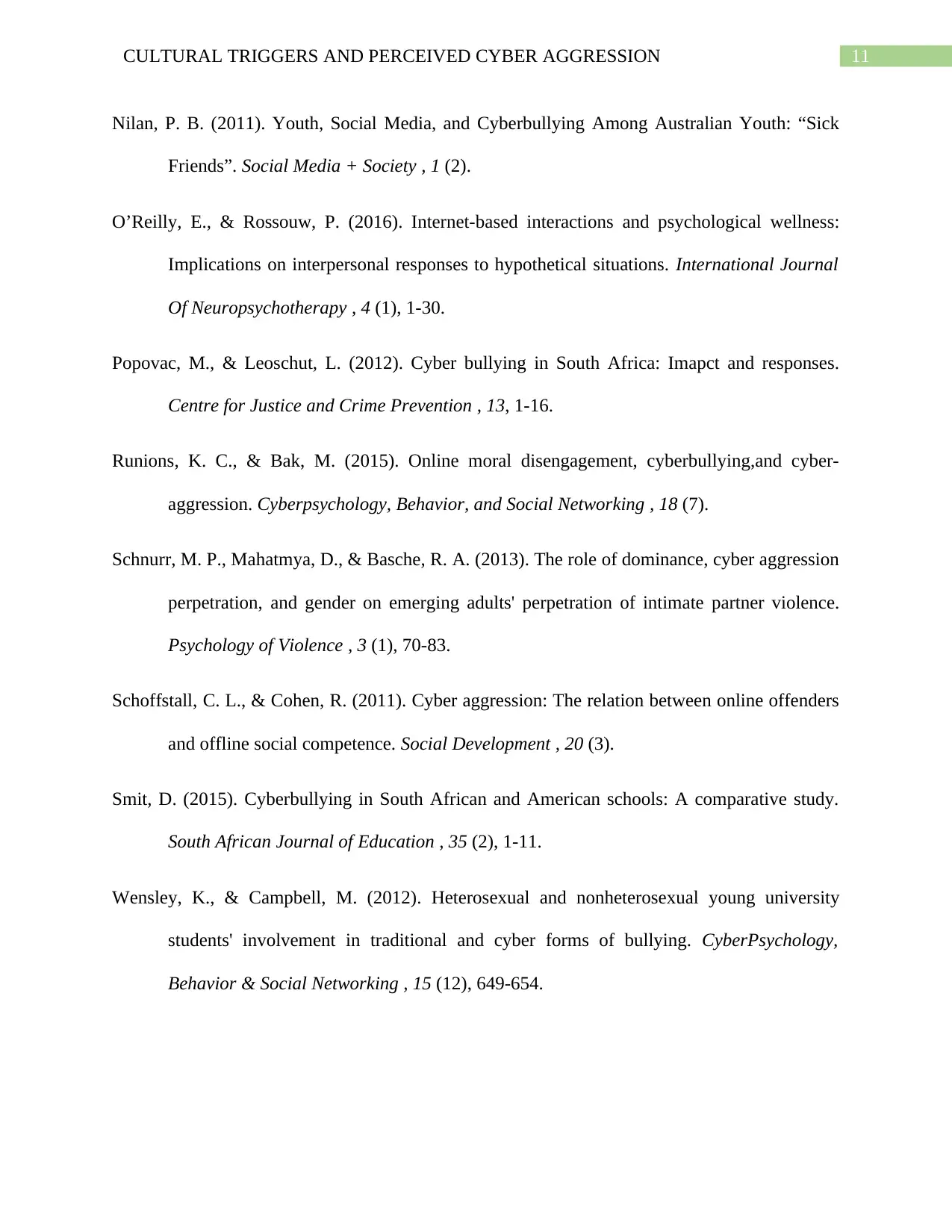
11CULTURAL TRIGGERS AND PERCEIVED CYBER AGGRESSION
Nilan, P. B. (2011). Youth, Social Media, and Cyberbullying Among Australian Youth: “Sick
Friends”. Social Media + Society , 1 (2).
O’Reilly, E., & Rossouw, P. (2016). Internet-based interactions and psychological wellness:
Implications on interpersonal responses to hypothetical situations. International Journal
Of Neuropsychotherapy , 4 (1), 1-30.
Popovac, M., & Leoschut, L. (2012). Cyber bullying in South Africa: Imapct and responses.
Centre for Justice and Crime Prevention , 13, 1-16.
Runions, K. C., & Bak, M. (2015). Online moral disengagement, cyberbullying,and cyber-
aggression. Cyberpsychology, Behavior, and Social Networking , 18 (7).
Schnurr, M. P., Mahatmya, D., & Basche, R. A. (2013). The role of dominance, cyber aggression
perpetration, and gender on emerging adults' perpetration of intimate partner violence.
Psychology of Violence , 3 (1), 70-83.
Schoffstall, C. L., & Cohen, R. (2011). Cyber aggression: The relation between online offenders
and offline social competence. Social Development , 20 (3).
Smit, D. (2015). Cyberbullying in South African and American schools: A comparative study.
South African Journal of Education , 35 (2), 1-11.
Wensley, K., & Campbell, M. (2012). Heterosexual and nonheterosexual young university
students' involvement in traditional and cyber forms of bullying. CyberPsychology,
Behavior & Social Networking , 15 (12), 649-654.
Nilan, P. B. (2011). Youth, Social Media, and Cyberbullying Among Australian Youth: “Sick
Friends”. Social Media + Society , 1 (2).
O’Reilly, E., & Rossouw, P. (2016). Internet-based interactions and psychological wellness:
Implications on interpersonal responses to hypothetical situations. International Journal
Of Neuropsychotherapy , 4 (1), 1-30.
Popovac, M., & Leoschut, L. (2012). Cyber bullying in South Africa: Imapct and responses.
Centre for Justice and Crime Prevention , 13, 1-16.
Runions, K. C., & Bak, M. (2015). Online moral disengagement, cyberbullying,and cyber-
aggression. Cyberpsychology, Behavior, and Social Networking , 18 (7).
Schnurr, M. P., Mahatmya, D., & Basche, R. A. (2013). The role of dominance, cyber aggression
perpetration, and gender on emerging adults' perpetration of intimate partner violence.
Psychology of Violence , 3 (1), 70-83.
Schoffstall, C. L., & Cohen, R. (2011). Cyber aggression: The relation between online offenders
and offline social competence. Social Development , 20 (3).
Smit, D. (2015). Cyberbullying in South African and American schools: A comparative study.
South African Journal of Education , 35 (2), 1-11.
Wensley, K., & Campbell, M. (2012). Heterosexual and nonheterosexual young university
students' involvement in traditional and cyber forms of bullying. CyberPsychology,
Behavior & Social Networking , 15 (12), 649-654.
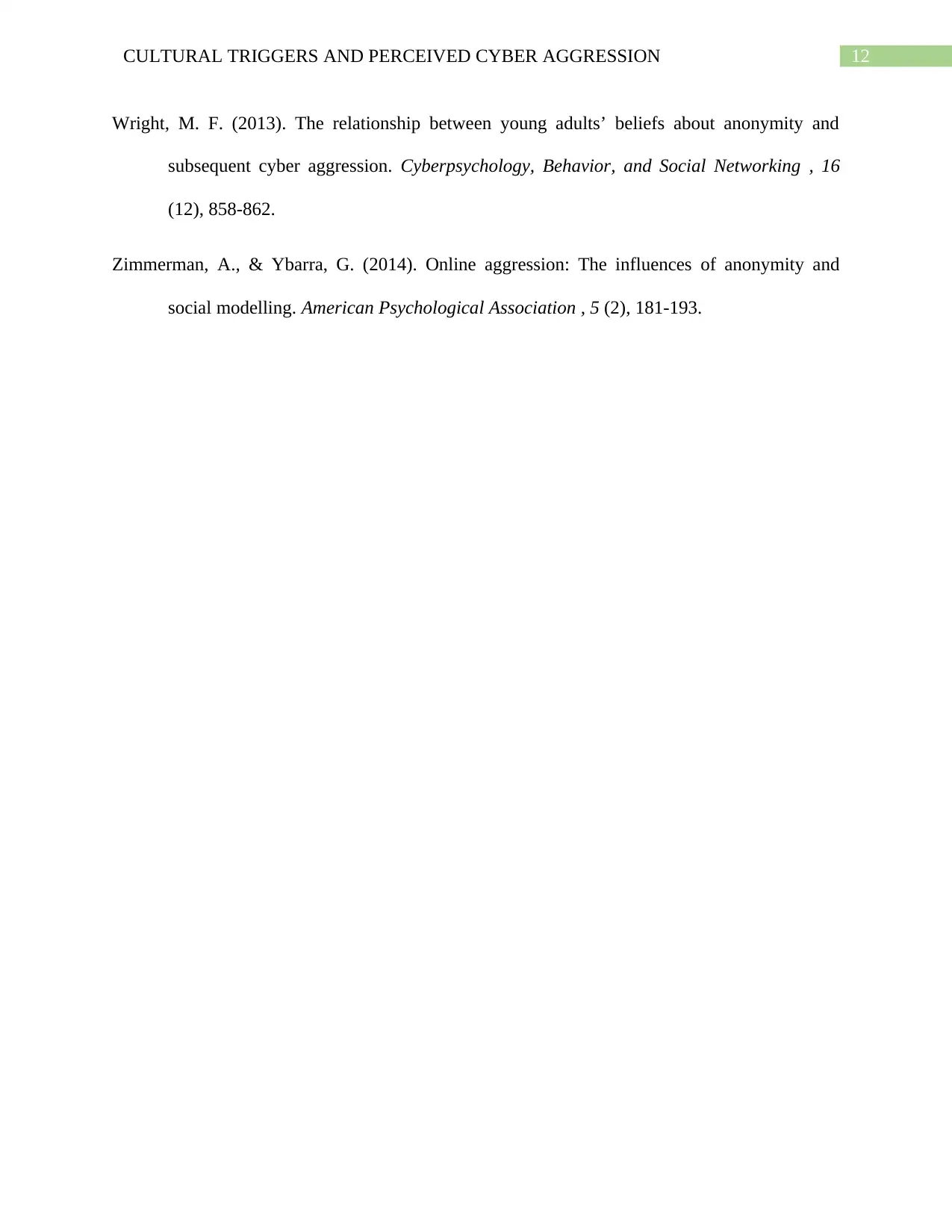
12CULTURAL TRIGGERS AND PERCEIVED CYBER AGGRESSION
Wright, M. F. (2013). The relationship between young adults’ beliefs about anonymity and
subsequent cyber aggression. Cyberpsychology, Behavior, and Social Networking , 16
(12), 858-862.
Zimmerman, A., & Ybarra, G. (2014). Online aggression: The influences of anonymity and
social modelling. American Psychological Association , 5 (2), 181-193.
Wright, M. F. (2013). The relationship between young adults’ beliefs about anonymity and
subsequent cyber aggression. Cyberpsychology, Behavior, and Social Networking , 16
(12), 858-862.
Zimmerman, A., & Ybarra, G. (2014). Online aggression: The influences of anonymity and
social modelling. American Psychological Association , 5 (2), 181-193.
1 out of 13
Related Documents
Your All-in-One AI-Powered Toolkit for Academic Success.
+13062052269
info@desklib.com
Available 24*7 on WhatsApp / Email
![[object Object]](/_next/static/media/star-bottom.7253800d.svg)
Unlock your academic potential
© 2024 | Zucol Services PVT LTD | All rights reserved.



